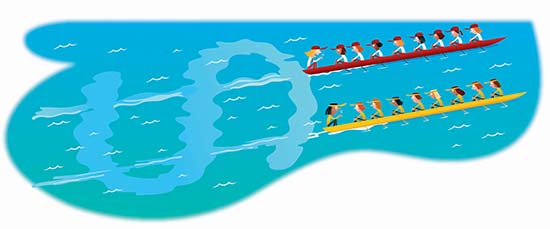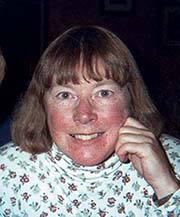 |
 |
| current issue |  | past issues |  | send a letter/news |  | address update |  | advertise |  | about us |  | alumni home |
Campus Currents
|
Making Waves
Julia A. Waltz loved open water, good boats— and a race to the finish. |
Easy to print version |
 Illustration by Jim Paillot |
One of the few times Julie A. Waltz '71G ever craved dry land more than open water came in 1978, when a storm off the coast of Puerto Rico sent whipping winds and crashing waves across the bow of her sailboat, tearing away both the mainsail and the jib. Somehow she and the friends she was sailing with managed to make it to shore, drenched and shaken. "I was never so glad to finally reach land," she told her friend Margaret Waugh '58 when she returned. But the experience didn't keep her landlocked for long.

Julie A. Waltz’s gift was a surprise that college officials learned of only after her death, but planned giving has always played a large part in UNH’s growth and prosperity. The university owes its Durham campus to an 1890 bequest from a wealthy farmer, Benjamin Thompson, who left both the land and the money to develop it. Planned donations range in size and scope, and while most take the form of bequests, like Waltz’s and Thompson’s, in which the gift is written into the donor’s will, some people set up trusts or donate real estate earlier in their lives. Some donors leave their gifts unrestricted, allowing UNH to apply the funds to areas of greatest need, but gifts can be earmarked for any purpose the donor chooses—from scholarships to program support. And while some bequests come as a surprise, many donors work with the UNH Office of Gift Planning to specify their wishes in advance. “Being notified helps us to be sure we’re best honoring the donor’s intentions,” says Theresa Soracco, director of gift planning. “The beauty of planned giving is that we can customize something to work with donors’ needs, and help them take advantage of tax incentives, all while making a legacy gift to UNH.” |
Athletic and fiercely competitive, Waltz loved sailing and rowing more than anything. But she also treasured her time at UNH, where she earned a master's degree in English literature. So Waltz, who died in 2010 at age 62, left behind a legacy that would help UNH students share the activities that gave her joy: a $50,000 donation to be divided equally between the sailing program and the women's crew program.
"Julie's gift came at a very opportune time," says head sailing coach Diana Weidenbacker. The sailing team, whose budget has been tied up in rebuilding and resupplying the boathouse that burned down in 2010, voted to use part of the money for new docks and new racing sails. "It allowed us to move in the direction we've been wanting to go for several years but couldn't."
The gift was one of a number of bequests Waltz made, many of them boating-related. She gave money in her native Maine to the crew team at Bates College, where she earned her bachelor's degree; she also donated to the Beach Preservation Society in Duxbury, Mass., where she lived as an adult and was active in the Yacht Club and a rugged sailing group called the Frostbiters, who raced on winter mornings in the icy bay.
"She was a devoted sailor," says Waugh, who often sailed with Waltz, although she jokingly complains that Waltz had a tendency to commandeer whatever boat she was in—even when it was Waugh's.
The UNH crew team used part of the money to buy a new Olympic-class rowing shell and christened it the Julie A. Waltz. Bates, it turned out, bought the same boat—and gave it the same name. So when the teams squared off last spring, it was the Julie A. Waltz against the Julie A. Waltz—two boats in a neck-and-neck race that was a fitting tribute to their shared namesake. The Bates team won by a mere 1.7 seconds.
"It was so cool to see our teams honoring the same woman through the tradition of aggressive racing," says UNH head women's rowing coach Rachel Rawlinson '99, '04G. And Waltz's bequest gave the rowers more than just a competitive advantage. "It's an important lesson for the students that philanthropy is alive and well, that people take care of each other," Rawlinson says. "They realized, 'I'm part of a bigger picture.'"
blog comments powered by Disqus

